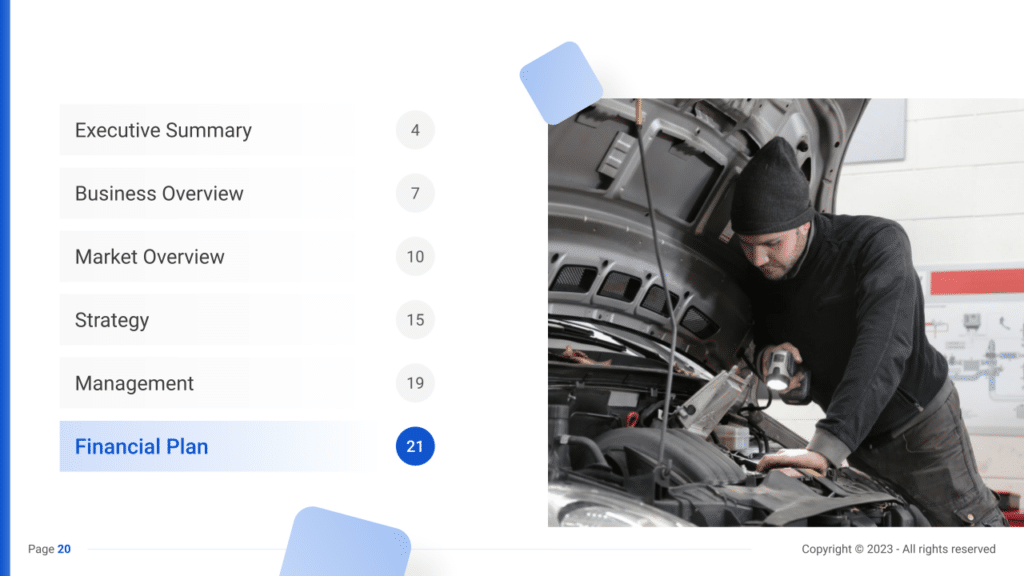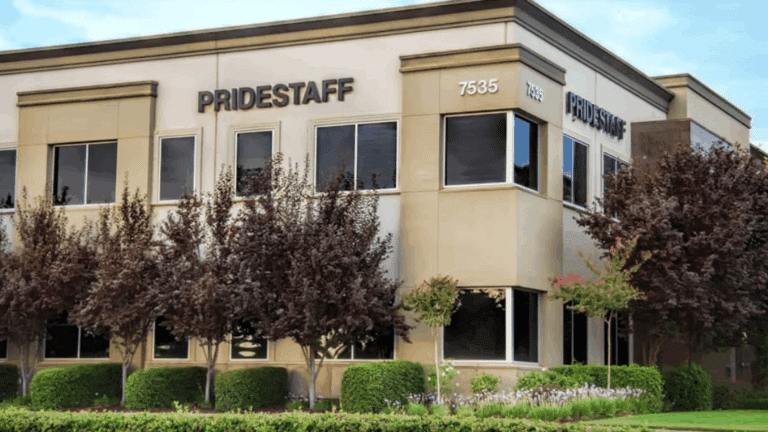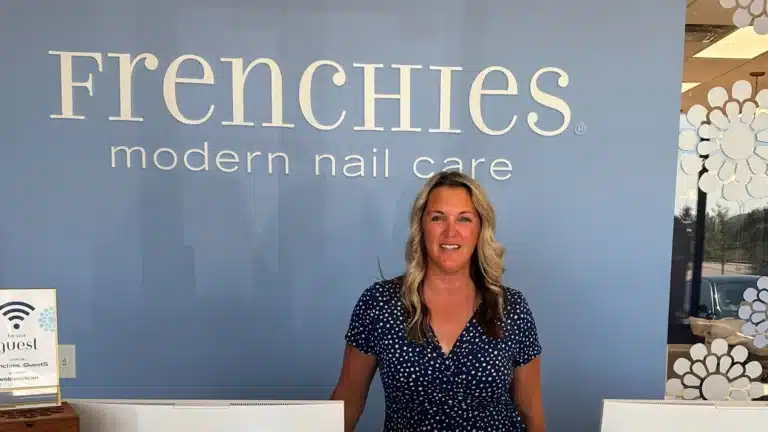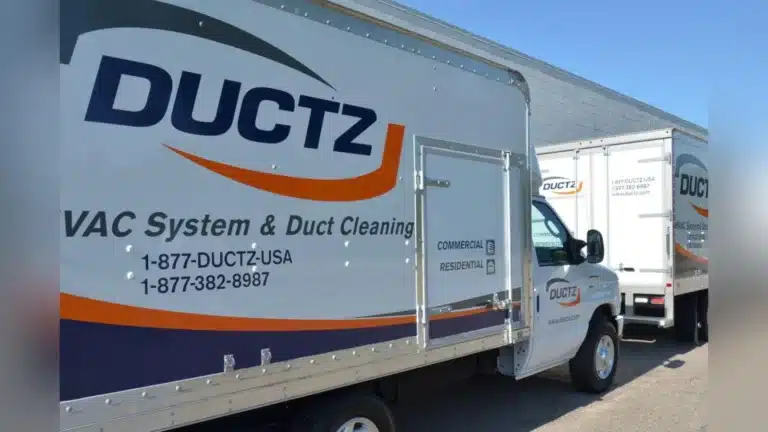Auto Repair Business Plan Template & PDF Example
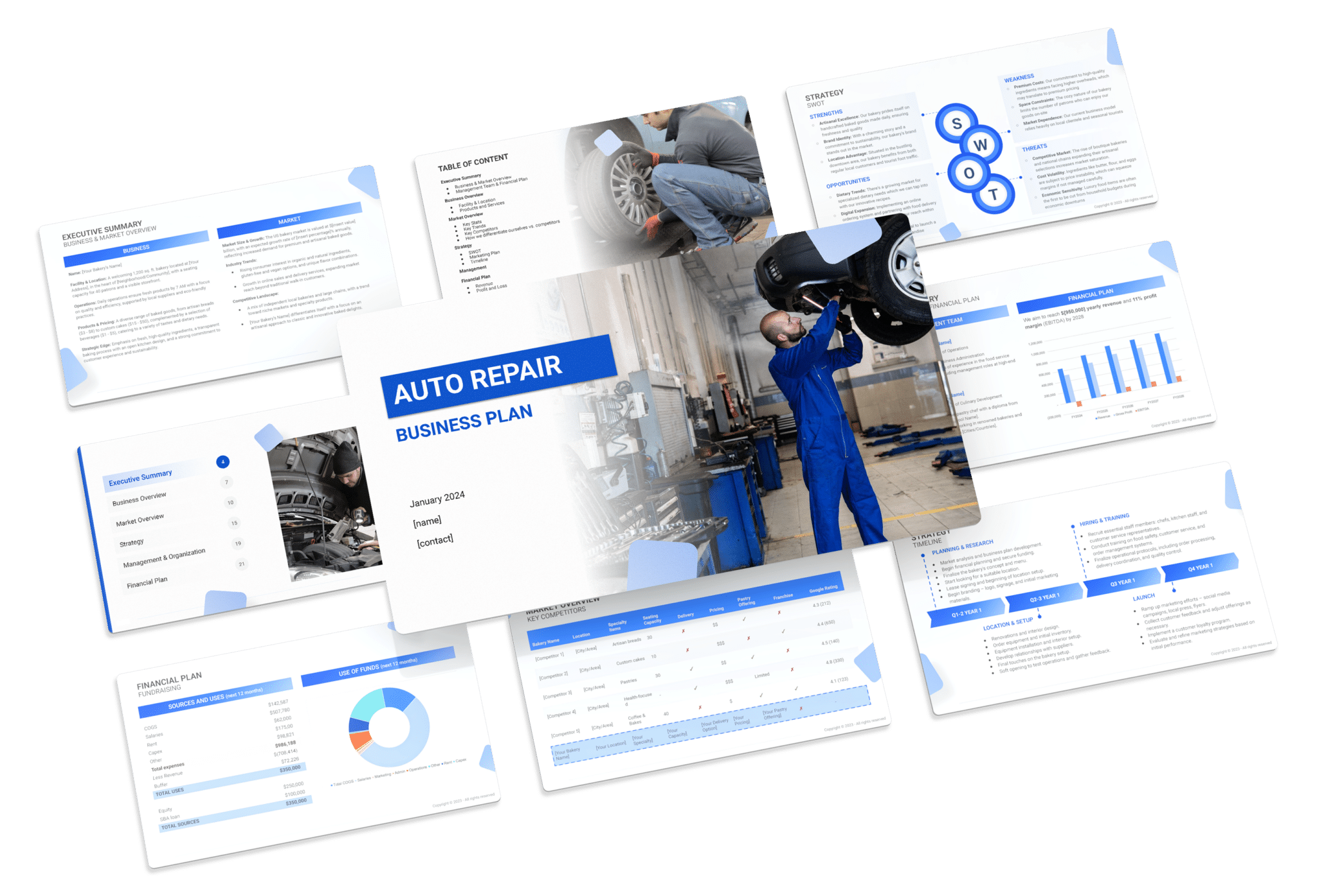
Creating a comprehensive business plan is crucial for launching and running a successful auto repair business. This plan serves as your roadmap, detailing your vision, operational strategies, and financial plan. It helps establish your auto repair business’s identity, navigate the competitive market, and secure funding for growth.
This article not only breaks down the critical components of an auto repair business plan, but also provides an example of a business plan to help you craft your own.
Whether you’re an experienced entrepreneur or new to the service industry, this guide, complete with a business plan example, lays the groundwork for turning your auto repair business concept into reality. Let’s dive in!
The Plan
Our auto repair business plan is structured to cover all essential aspects needed for a comprehensive strategy. It outlines the garage’s operations, marketing strategy, market environment, competitors, management team, and financial forecasts.
- Executive Summary: Offers an overview of your auto repair business’s concept, market analysis, management, and financial strategy.
- Business Overview: Provides detailed information on what your auto repair business offers and its operational model:
- Services & Location: Describes the shop’s facilities, services offered, and why its location is beneficial for customers.
- Operational Details: Outlines the operational aspects like workshop layout, equipment used, and staff roles.
- Market Overview: Examines the auto repair industry landscape, identifying competitors and how your business differentiates:
- Key Stats: Presents data on market size, growth trends, and customer demographics.
- Key Trends: Highlights technological advancements and changing consumer preferences in auto repair.
- Key Competitors: Analyzes main competitors in the area and your business’s unique selling points.
- Strategy: Details how the auto repair business plans to achieve growth and attract clients:
- SWOT: Conducts a strengths, weaknesses, opportunities, and threats analysis.
- Marketing Plan: Discusses strategies to draw in and keep customers, including promotional activities and customer service enhancements.
- Timeline: Lists important goals and milestones from the outset through the first year.
- Management: Provides information on the auto repair business management team and their responsibilities.
- Financial Plan: Forecasts the business’s 5-year financial performance, including expected income, profit margins, and outlays.

Executive Summary
The executive summary is a critical component of your bike shop business plan. It offers a concise yet comprehensive view of your business within the bike retail and service market, including competitive analysis and financial forecasts. This section is crucial for attracting investors and partners, as it highlights your business’s potential and strategic plans.
A two-slide PowerPoint presentation is recommended for this summary. The first slide should detail your business model, covering the range of products and services unique to your bike shop. The second slide should focus on your management team’s qualifications and financial goals, giving a snapshot of anticipated market performance and growth prospects.
Auto Repair Business Plan Executive Summary Example
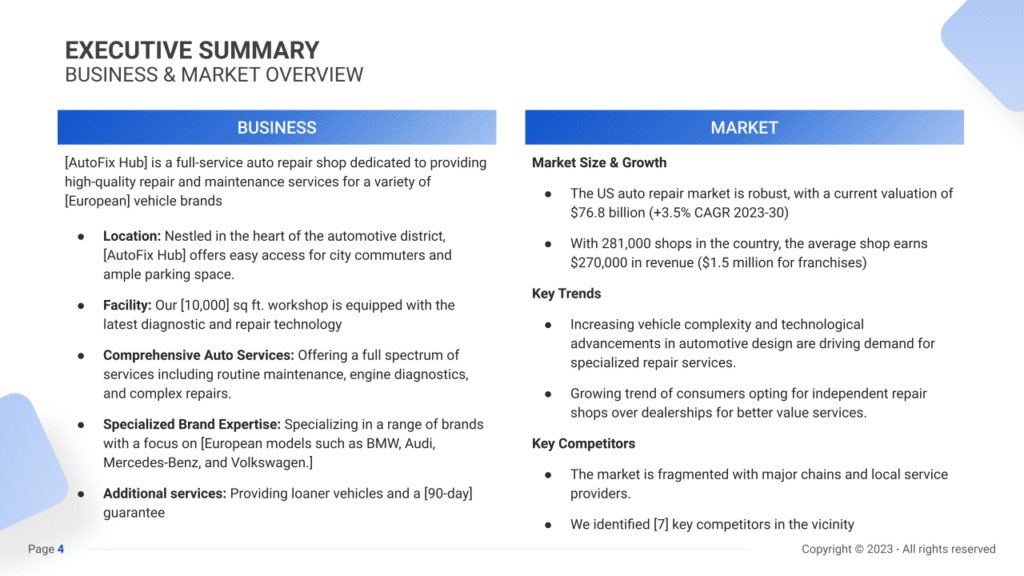
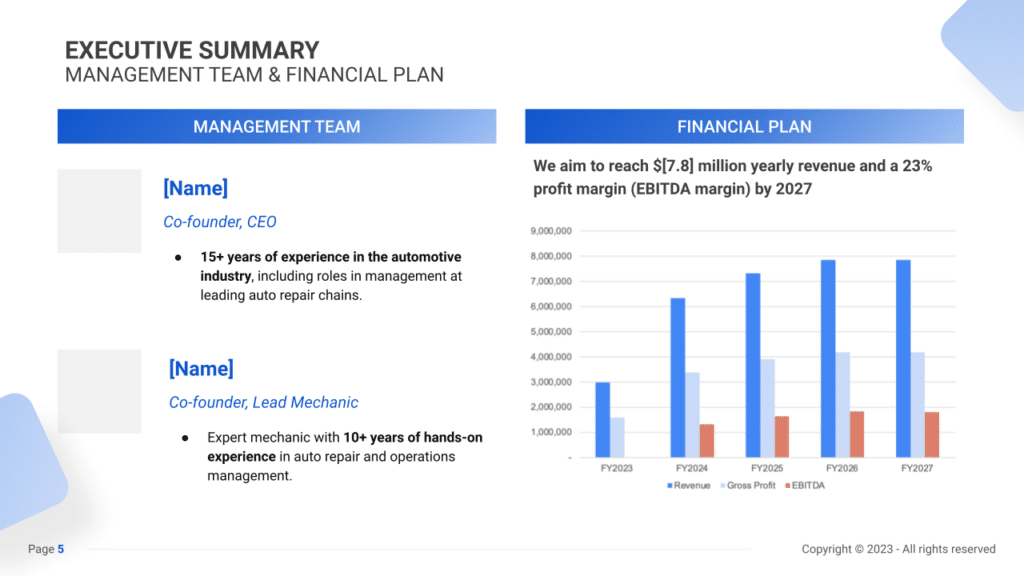
Business Overview
In the executive summary of an auto repair shop business plan, the business overview section is crucial for detailing the shop’s offerings and operational capabilities. This includes the shop’s location, facility features, range of services, brand specialization, and any additional customer-focused services.
For an auto repair shop, it’s important to emphasize the expertise in specific vehicle brands, the advanced technological equipment available, and the comprehensive nature of services offered, from routine maintenance to complex repairs. The inclusion of customer convenience features, such as loaner vehicles and service guarantees, also plays a significant role in differentiating the shop in the market.
Example:
AutoFix Hub, situated in a prime automotive district, operates from a 10,000 sq ft workshop equipped with state-of-the-art diagnostic and repair tools. Specializing in European brands like BMW and Mercedes-Benz, the shop offers a full spectrum of services and stands out with additional customer conveniences like loaner vehicles and a 90-day service guarantee.
Market Overview
The market analysis section should assess the size, growth, trends, and competitive landscape of the auto repair industry. It’s crucial to provide insights into the industry’s dynamics, such as the demand for specialized repair services due to increasing vehicle complexity and the shift of consumer preference towards independent repair shops.
Understanding the competitive environment, including the presence of major chains and local service providers, is vital for identifying the shop’s market position and opportunities for growth.
Example:
The US auto repair market, valued at $76.8 billion, is growing steadily. AutoFix Hub is positioned in a market with 281,000 shops, differentiating itself through specialized services for European models. The shop capitalizes on the trend of consumers preferring independent shops for better value, distinguishing itself among 7 key local competitors.
Management Team
In this section, the focus is on the background and expertise of the management team leading the auto repair shop. It’s important to highlight their experience in the automotive industry and their roles within the shop.
The management team’s qualifications are a key aspect of the business’s ability to deliver quality services and manage operations efficiently. This part of the summary should instill confidence in the team’s capabilities to drive business growth and maintain high standards of service.
Example:
The CEO, a co-founder of AutoFix Hub, brings over 15 years of industry experience, including management roles at leading auto repair chains. The Lead Mechanic, also a co-founder, possesses extensive expertise in servicing European models, ensuring high-quality repair work and customer satisfaction.
Financial Plan
The financial plan overview provides a snapshot of the auto repair shop’s revenue and profit targets. It outlines the financial goals, including specifics like aiming to reach $7.8 million in annual revenue with a 23% EBITDA margin by 2027.
This section reflects the shop’s financial health and potential for profitability, taking into account market positioning, service offerings, and operational strategies.
Example:
AutoFix Hub aims to achieve $7.8 million in yearly revenue with a 23% profit margin by 2027. This financial goal is underpinned by strategic expansion of services, targeting high-value vehicle brands, and leveraging the growing consumer trend towards independent repair shops for specialized services.
Business Overview
For an auto repair business, the Business Overview section can be effectively divided into 2 main sections:
Garage & Location
Briefly describe the garage’s physical setup, focusing on its layout, functionality, and the welcoming environment it creates for customers.
Mention the business’s location, emphasizing its ease of access and the convenience it offers to customers, such as proximity to major roads or availability of ample parking. Explain why this location is strategically chosen to attract your target clientele, considering factors like high traffic volume or lack of similar services in the area.
Services & Pricing
Detail the range of maintenance and repair services offered, from routine services like oil changes and tire rotations to more specialized repairs such as engine diagnostics, transmission work, or electrical system repairs.
Outline your pricing strategy, ensuring it mirrors the quality of services provided and aligns with the market segment you’re targeting. Highlight any service bundles, membership deals, or loyalty programs that offer added value to your customers, fostering repeat business and customer loyalty.
Make sure to cover here
_ Services & Location
_ Operational Details


Market Overview
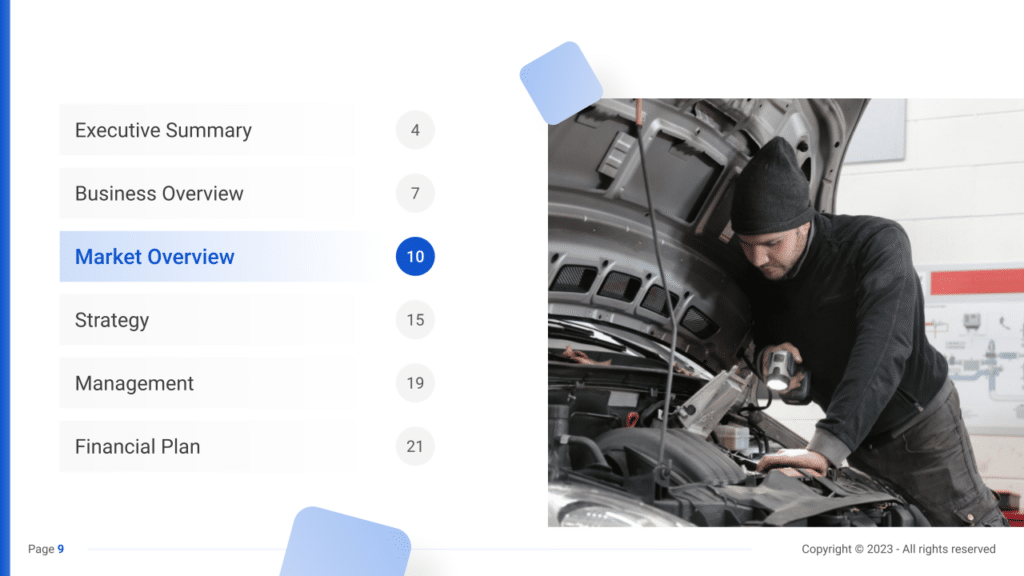
Industry size & growth
Begin with an overview of the auto repair industry, noting its size and potential for growth. Highlight key factors like the increasing vehicle population, aging car fleets, and trends towards vehicle longevity.
Key market trends
Next, discuss current trends such as the demand for specialized services, the rise of new automotive technologies, and eco-friendly repair practices. Emphasize the growing need for expertise in electric and hybrid vehicle maintenance and advanced diagnostics.
Key competitors
A competitive analysis is not just a tool for gauging the position of your auto repair shop in the market and its key competitors; it’s also a fundamental component of your business plan.
This analysis helps in identifying your auto repair shop’s unique selling points, essential for differentiating your business in a competitive market.
In addition, competitive analysis is integral in laying a solid foundation for your business plan. By examining various operational aspects of your competitors, you gain valuable information that ensures your business plan is robust, informed, and tailored to succeed in the current market environment.
Identifying Your Competitors in the Auto Repair Industry
Begin by identifying and mapping out local auto repair shops, dealerships offering repair services, and franchises specializing in car maintenance within your vicinity. Direct competitors include shops offering similar services or catering to similar vehicle types, while indirect competitors might involve dealerships with in-house repair centers or mobile repair services.
Leverage online resources such as Google Maps and review platforms like Yelp and Angie’s List to gather insights into competitor locations, customer feedback, and service ratings. Positive reviews praising the expertise and quick turnaround at “Speedy Auto Care” highlight a strength that your competitor possesses in the market.

Auto Repair Competitors’ Strategies
A comprehensive analysis of competitors’ strategies encompasses various operational dimensions:
- Service Portfolio: Evaluate the spectrum of services offered. For instance, a competitor like “Eco-Green Auto Care” gaining traction by specializing in eco-friendly repairs and using sustainable practices signifies an emerging market trend towards environmentally conscious auto maintenance.
- Technical Expertise: Consider the technical proficiency and specialized services provided. An auto shop like “Performance Motorsport Garage” focusing on high-performance vehicle tuning might cater to a different clientele compared to a shop specializing in general repairs.
- Pricing and Packages: Conduct a detailed comparison of service pricing structures with competitors. Is your shop positioned similarly to “Affordable Auto Fixes” or more aligned with premium services offered at “Elite Car Service Centre”?
- Marketing Strategies: Analyze competitors’ marketing approaches. Are they investing heavily in digital advertising, local sponsorships, or community engagement to bolster brand visibility and customer reach?
- Customer Experience: Evaluate the overall customer journey. Perhaps “Friendly Auto Repairs” excels in customer service by offering conveniences such as online appointment scheduling, shuttle services, or a dedicated customer portal.
- Operational Efficiency: Observe technological advancements or innovative processes adopted by competitors. For example, “Tech-Forward Motors” might utilize AI-powered diagnostics or automated service reminders for enhanced customer engagement and operational efficiency.
What’s Your Auto Repair Shop’s Value Proposition?
Define your shop’s distinctive value proposition. It could be specialized services such as transmission rebuilds, a focus on superior customer service, or offering a comprehensive maintenance package with added value services like complimentary car washes or extended warranties.
Identify market gaps by analyzing customer feedback, industry trends, and unmet needs within the automotive repair sector. For instance, an increasing demand for electric vehicle maintenance might signal an opportunity for your shop to invest in training technicians for EV-specific repairs, thus addressing a niche market segment overlooked by competitors.
Tailor your approach based on location: A shop situated in a suburban area might emphasize personalized services, loyalty programs, and extended warranties to build lasting relationships with local customers. In contrast, an urban location might focus on quick turnaround times and express services to cater to the fast-paced lifestyle of city dwellers.
Strategy
SWOT
First, perform a SWOT analysis for your auto repair business, identifying Strengths (such as highly skilled technicians and a broad range of services), Weaknesses (like high operational costs or intense competition), Opportunities (for instance, the growing demand for maintenance of aging vehicles), and Threats (such as economic downturns impacting consumer spending on non-essential repairs).
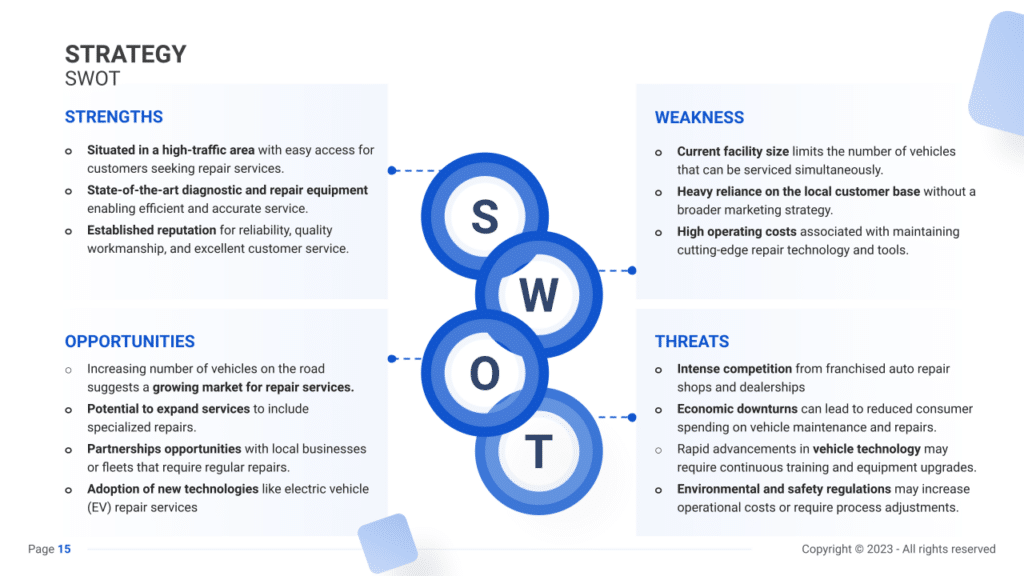
Marketing Plan
Then, craft a marketing strategy detailing how to draw in and keep customers through targeted advertising, promotional offers, a strong online presence, and involvement in local community events.
Marketing Channels
Utilize various marketing channels to communicate your brand and services, engage with potential clients, and drive foot traffic to your shop.
Digital Marketing
- Online Presence: Maintain a professional website that showcases your services, customer testimonials, and informative content about automotive maintenance and care. Optimize your website for local SEO to improve visibility in local search results.
- Social Media: Utilize platforms like Facebook, Instagram, Twitter, and YouTube to showcase your expertise through before-and-after repair images, customer testimonials, and educational content. Engage with your audience by responding promptly to inquiries and comments.
- Email Marketing: Build an email list by offering valuable content or discounts in exchange for sign-ups. Send regular newsletters featuring promotions, DIY car care tips, and updates about new services or events.
Local Advertising
Connect with your local community through targeted advertising efforts:
- Local Publications: Advertise in local newspapers, magazines, or community newsletters to reach a wider audience. Consider sponsoring specific automotive sections or publishing informative articles on car maintenance.
- Community Engagement: Participate in local car shows, street fairs, or dealership events. Offer free vehicle check-ups or workshops on basic car maintenance to showcase your expertise and build rapport with potential customers.
- Collaborations: Partner with car dealerships, rental companies, or local businesses for mutually beneficial promotions or referral programs. Cross-promotions can expand your reach within the local market.

Sales Channels
Optimize sales channels to maximize revenue and enhance customer satisfaction.
In-Shop Sales Techniques
- Service Upgrades: Train your staff to suggest additional services or maintenance checks during customer interactions. For instance, recommending a wheel alignment with a tire change or a fluid flush with an oil change can add value to the customer’s visit.
- Retail Merchandise: Display automotive care products or accessories prominently within your shop. Educate customers on their benefits and relevance to vehicle maintenance.
- Service Packages: Offer bundled services, such as a ‘Seasonal Maintenance Package’ or ‘Pre-Trip Inspection,’ to incentivize customers and simplify their automotive care choices.
Online Sales Integration
Leverage technology for streamlined sales processes:
- Online Appointment Booking: Implement an easy-to-use online booking system on your website and social media platforms. Offer incentives like discounts or priority scheduling for online bookings.
- E-Commerce Integration: Consider selling car care products, accessories, or merchandise online. Offering package deals on services or maintenance kits can attract customers looking for convenience.
- Virtual Consultations: Provide online consultations for basic troubleshooting or pre-service assessments. This personalized approach can lead to tailored service bookings or product recommendations, enhancing the customer experience.
Membership & Loyalty Programs
Encourage customer retention and repeat business:
- Membership Options: Create membership plans offering discounted rates for routine maintenance services or exclusive benefits such as priority scheduling or complimentary check-ups.
- Loyalty Rewards: Implement a digital loyalty program where customers earn points for every service or purchase. These points can be redeemed for discounts on future repairs or merchandise, fostering long-term customer relationships.
Timeline
Lastly, set up a comprehensive timeline highlighting key milestones for the auto repair shop’s launch, marketing initiatives, customer base development, and expansion goals, ensuring the business progresses with clear objectives and purpose.

Management
The Management section focuses on the auto repair business’s management and their direct roles in daily operations and strategic direction. This part is crucial for understanding who is responsible for making key decisions and driving the auto repair business toward its financial and operational goals.
For your auto repair business plan, list the core team members, their specific responsibilities, and how their expertise supports the business.
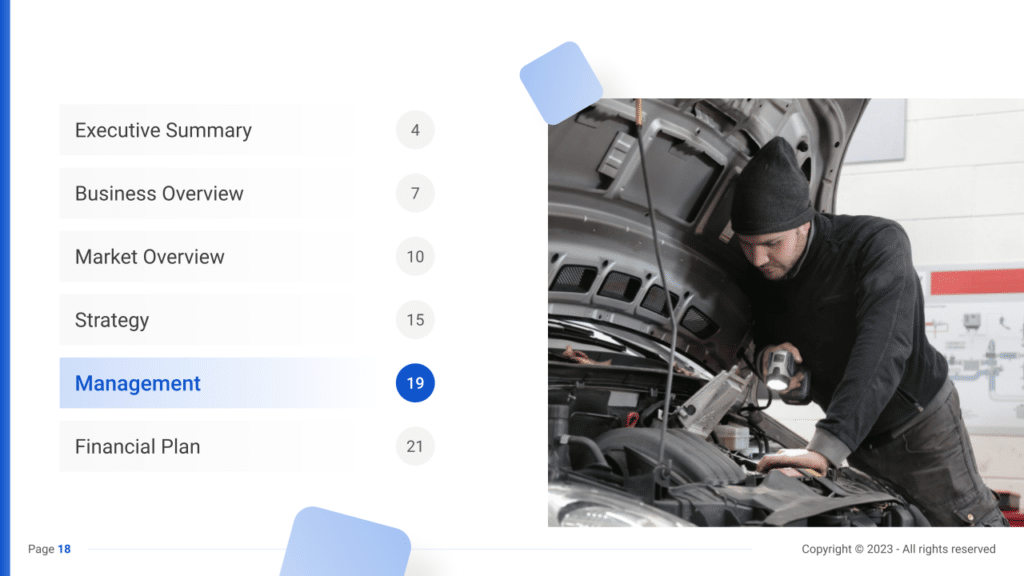

Financial Plan
The Financial Plan section is a comprehensive analysis of your financial projections for revenue, expenses, and profitability. It lays out your auto repair business’s approach to securing funding, managing cash flow, and achieving breakeven.
This section typically includes detailed forecasts for the first 5 years of operation, highlighting expected revenue, operating costs and capital expenditures.
For your auto repair business plan, provide a snapshot of your financial statement (profit and loss, balance sheet, cash flow statement), as well as your key assumptions (e.g. number of customers and prices, expenses, etc.).
Make sure to cover here
_ Profit and Loss
_ Cash Flow Statement
_ Balance Sheet
_ Use of Funds
